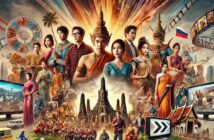PriceWaterhouseCoopers Global Leader, Entertainment & Media Marcel Fenez introduced PwC’s media outlook through 2015 by sharing statistics from the TV ad market, making a crucial distinction that some may find controversial.
Moving forward, « share of TV » shall include mobile screens as well as online, bringing two controversial alternatives to traditional TV back to where they « rightfully belong », Fenez stated.
- TV’s share of total advertising will increase from 38% in 2010 to 40% in 2015. Again, this includes online and mobile.
- In 2015, China will overtake Japan as second-largest TV market (of which US remains the top with 4.9%).
- Growth in consumer spend on TV will also eclipse spend on any other industry.
Here are the qualities that Fenez says are inevitable indicators of our increasingly collaborative future.
- Digitally Empowered Consumer
- The Involved Advertiser
- Collaboration: Route to Competitive Advantage
« At a time when [consumers are]saying they want more stuff free, they’re also giving us a hint of what they’re actually willing to pay for », Fenez added, elaborating on the « digitally empowered consumer ».
Beside content, consumers have demonstrated enthusiastic interest in paying for:
- Convenience
- Experience
- Quality
- Participation
- Privilege
Involved advertisers can take advantage of these opportunities by prioritising the following:
- Engagement with digital natives in their own space
- Personalised interaction
- Compelling content and intensity of experience
- Cross-platform reach
- Verifiable evidence of consumer engagement
Fenez calls the operating model for the digital future « The Collaborative Digital Enterprise ». It is defined thus:
« An enterprise that is dynamic, interconnected, and continuously engaged with its entire customer, employee and supplier ecosystem, enabled by technology. »
Your imperatives for future success:
- Data mining
- Data security
- Future-proof content
- End-to-end digital workflow
- Digital talent management
In case you’re wondering about that last point, digital talent can be roughly defined as the dynamic new workforce of tomorrow (and, in growing numbers, today). These aren’t people who work one job for 20 years; they’re people who work five jobs in five years, Fenez said.
The question for you is, how do you find digital talent, retain it and remunerate it?




